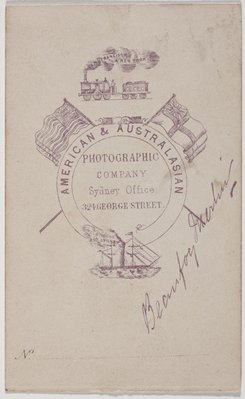-
Details
- Date
- 1870-1873
- Media category
- Photograph
- Materials used
- carte de visite
- Dimensions
- 6.0 x 10.0 cm image; 6.4 x 10.5 cm mount card
- Signature & date
Not signed. Not dated.
- Credit
- Purchased 2014
- Location
- Not on display
- Accession number
- 399.2014
- Copyright
- Artist information
-
Henry Beaufoy Merlin
Works in the collection
- Share
-
-
About
The American and Australasian Photographic Company (A & A Photographic Company) was established by Beaufoy Merlin in Melbourne. With his assistant Charles Bayliss, Merlin commenced an ambitious project to photograph every house and building in Victoria and New South Wales. The aim of this venture was to create an image library of the colonies so that properties could be viewed for investment or insurance purposes. The objective, as presented in the ‘Sydney Morning Herald’ 21 September 1870, was to promote ‘a novel means of social and commercial intercourse’.
An encounter with entrepreneur B O Holtermann in the Gold Rush town of Hill End in 1872 resulted in another remarkable project: an International Travelling Exposition containing photographs, raw materials, zoological specimens, amongst others. The centrepiece was to be a mammoth panorama of Sydney necessitating the production of wet plate negatives of 97 x 160 cm, the largest in existence.
Merlin retired as NSW manager of A & A Photographic Company in 1872 and died a year later. By then, there were A & A offices in Sydney, Melbourne, Hill End and Gulgong, though not, as the cartes de visite claimed, in San Francisco or New York.
A carte de visite is a stiff card of about 10 x 6.4 cm, with an attached paper photograph, invented in 1854 by André-Adolphe-Eugène Disderi. They were introduced into Australia in 1859 by William Blackwood with albums arriving in 1860, aiding the collection and distribution of multiple cartes. Cartes were usually portraits and were made by the millions worldwide. Multi-lens, or ‘multiplying’ cameras were introduced in the 1860s, which were capable of producing from 2 to 32 images in quick succession, dramatically increasing the number of cartes de visite that could be made from a single photographic plate. They were easily reproduced by making paper contact prints from the glass plates, which were then cut and pasted to card.
-
Exhibition history
Shown in 1 exhibition
The photograph and Australia, Art Gallery of New South Wales, Sydney, 21 Mar 2015–08 Jun 2015
The photograph and Australia, Queensland Art Gallery, South Brisbane, 04 Jul 2015–11 Oct 2015





